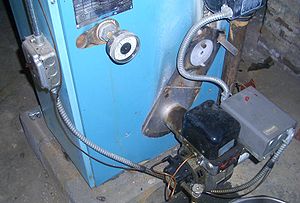This article needs additional citations for verification. (February 2016) |

An oil burner is a heating device which burns #1, #2 and #6 heating oils, diesel fuel or other similar fuels. In the United States, ultra low sulfur #2 diesel is the common fuel used. It is dyed red to show that it is road-tax exempt. In most markets of the United States, heating oil is the same specification of fuel as on-road un-dyed diesel.
An oil burner is a part attached to an oil furnace, water heater, or boiler.[1] It provides the ignition of heating oil/biodiesel fuel used to heat either air or water via a heat exchanger. The fuel is atomized into a fine spray usually by forcing it under pressure through a nozzle which gives the resulting flame a specific flow rate, angle of spray and pattern (variations of a cone shape). This spray is usually ignited by an electric spark with the air being forced through around it at the end of a blast tube, by a fan driven by the oil burner motor.[2] The fuel pump is typically driven via a coupling connecting its shaft to the motor.
In the United States residential home heating oil market the "vaporizing gun burner" is the most common mechanical device used to heat a home or small commercial forced air space with.[3] These simple burners may achieve a lifespan of several decades with regular maintenance.
The maintenance in a gun burner usually involves a replacement of the nozzle used to atomize the fuel, replacing the filter located at the air handler, replacing the fuel filter on the heating oil system from the tank, cleaning out any soot or deposits in the heat exchanger of the furnace, and ensuring the system is in good working order. It also involves checking and adjusting the fuel-air mixture for efficiency with a combustion analyzer.
If a heating oil burner runs out of oil, it often must be primed to be restarted. Priming involves purging any air from the fuel lines so that a steady flow of oil can find its way to the burner.
If an oil burner wears out, it can usually be upgraded and replaced with a more efficient modern burner. If the heat exchanger wears out, a new furnace is required. Oil furnaces can last decades if maintained regularly ensuring the heat exchanger is vacuumed out and cleaned. Oil burners deposit soot in the heat exchanger, which insulates unevenly and causes temperature gradients and uneven stresses throughout the steel, potentially leading to cracking. Annual or every other year tune-ups guarantee this wear is far reduced. Oil furnace lifespans of 50-75 years with regular service are not uncommon, compared to the approximately 20-year lifespan of natural gas furnaces.
- ^ "Thermopride Oil Furnaces". thermopride.com. March 28, 2018. Retrieved March 28, 2018.
- ^ James L. Kittle (1990). Home Heating & Air Conditioning Systems. McGraw-Hill Professional. ISBN 0-8306-3257-3.
- ^ "Beckett Burner Corp". beckettcorp.com/. March 28, 2018.